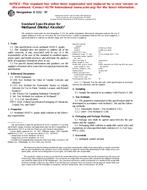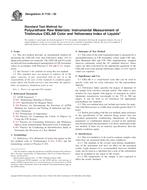1.1 This test method covers a suitable means of obtaining the thermal neutron fluence rate, or fluence, in well moderated nuclear reactor environments where the use of cadmium, as a thermal neutron shield as described in Method E262, is undesirable because of potential spectrum perturbations or of temperatures above the melting point of cadmium.
1.2 This test method describes a means of measuring a Westcott neutron fluence rate (Note 1) by activation of cobalt- and silver-foil monitors (See Terminology E170). The reaction 59Co(n,γ)60Co results in a well-defined gamma emitter having a half-life of 1925.28 days (1). The reaction 109Ag(n,˙γ) 110mAg results in a nuclide with a complex decay scheme which is well known and having a half-life of 249.76 days (1). Both cobalt and silver are available either in very pure form or alloyed with other metals such as aluminum. A reference source of cobalt in aluminum alloy to serve as a neutron fluence rate monitor wire standard is available from the National Institute of Standards and Technology (NIST) as Standard Reference Material 953. The competing activities from neutron activation of other isotopes are eliminated, for the most part, by waiting for the short-lived products to die out before counting. With suitable techniques, thermal neutron fluence rate in the range from 109 cm−2 · s−1 to 3 × 1015 cm−2 · s−1 can be measured. For this method to be applicable, the reactor must be well moderated and be well represented by a Maxwellian low-energy distribution and an (1/E) epithermal distribution. These conditions are usually met in positions surrounded by hydrogenous moderator without nearby strongly absorbing materials. Otherwise the true spectrum must be calculated to obtain effective activation cross sections over all energies.
Product Details
- Published:
- 01/01/2010
- Number of Pages:
- 7
- File Size:
- 1 file , 200 KB
- Redline File Size:
- 2 files , 380 KB


